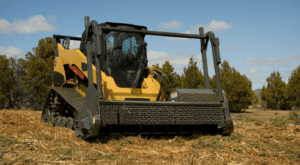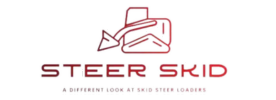Within the field of heavy machinery, the forklift and the skid steer loader are two common forms of equipment utilized for construction and material handling needs. Important tools in many different fields, both of these machines have unique abilities and strengths. But many people are not sure which of a skid steer loader or a forklift would be better. This page will compare and contrast these two machines in terms of their design, functionality, and uses to help you to understand their differences and direct your choice.

What is a Skid Steer Loader?
Designed for agility and adaptability, a skid steer loader—also called a skid steer or a skid loader—is a small, four-wheeled vehicle. Lift arms on it can be fastened with a variety of attachments including buckets, forks, grapples, and more. Its capacity to turn by skidding its wheels on one side while driving the other side in the opposite direction defines the moniker “skid steer”. This special steering system lets the skid steer operate in limited areas and turn precisely.
What is a Forklift?
A forklift, sometimes called a lift truck or fork truck, is a powered industrial truck used for short distance material lifting and movement. It comprises a mast with an elevating cargo carriage featuring fork attachments. To gather or drop goods, the prongs can be lifted or lowered. Forklifts exist in many sizes and capacities, ranging from small, hand-operated machines to massive, heavy-duty ones.
The Clark Equipment Company developed forklifts first in the early 20th century. Originally used in factories and warehouses for loading and unloading items, they But because to technological developments, forklifts find application in many different sectors, including manufacturing, logistics, and construction.
Design and Functionality
A skid steer loader and a forklift differ mostly in design and use. Skid steer loaders are low center of gravity, small frame compact machines. Working in confined areas is best for them since they are meant to be agile and nimble. From the rear of the machine, the operator views the work area clearly either from an enclosed cab or from an open platform.
By contrast, forklifts have a higher center of gravity and a bigger frame. They are meant to raise big weights to heights of up to thirty feet or more. The operator has a good view of the forks and the load being raised from their cab at the front of the machine.
Skid steer loaders are essentially utilized for excavating, pushing, and lifting materials in terms of utility. They can have several attachments including forks for lifting pallets, buckets for excavation, grapples for moving logs or rocks, and more. Because of their four-wheel drive system, skid steers are also well-known for their performance on slopes and difficult ground.
Conversely, forklifts are intended especially for transporting and lifting goods. Their forks allow one to lift or lower them to grab or drop goods. For managing various kinds of cargo, forklifts can also be fitted with attachments including rotators or clamps. When it comes to the variety of attachments that can be utilized, they are less flexible than skid steer loaders nevertheless.
Applications
Because of their design and purpose, skid steer loaders and forklifts find varied uses. In building, landscaping, and agriculture, skid steer loaders are rather often utilized. For chores including grading, loading, excavating, and material transportation, they are perfect. Skid steers find application in road maintenance, demolition, and snow removal as well.
Conversely, forklifts are mostly utilized for loading and unloading goods in warehouses, factories, and distribution centers. On building sites, they are also utilized to move goods to varying degrees of a structure. Manufacturing companies also frequently employ forklifts to handle large machinery and tools.
Safety Considerations
If improperly run, both forklifts and skid steer loaders can be dangerous. Every machine has certain safety issues, nevertheless, that are unique.
Because of their low center of gravity, skid steer loaders run more of a tipping over risk. Operators have to be taught how to run the machine safely and not turn sharply or drive on uneven ground. Additionally very important is the usage of seat belts to stop the operator from being flung out of the cab in should a tip-over.
Because of their weight and size, forklifts carry more danger of mishaps. Operators who want to run the machine safely and use correct lifting or moving techniques have to be educated. Driving with a raised load or overloading a forklift might cause it to topple over and inflict major injury or death.
Maintenance and Cost
Skid steer loaders offer a cost and maintenance benefit over forklifts. Since skid steers have less moving components than forklifts, maintenance of them is simpler. They also have a longer lifespan as they are built for heavy-duty operation. However, skid steer loaders can be more expensive upfront compared to forklifts.
Conversely, forklifts need constant maintenance to guarantee effective and safe running. Their greater number of moving components can raise maintenance expenses. For companies with a tighter budget, forklifts are therefore often a more reasonable choice since they are usually less costly than skid steer loaders.
Conclusion
Ultimately, both forklifts and skid steer loaders have certain qualities that make them indispensable instruments in different sectors. Compact and adaptable tools perfect for operating in confined areas and challenging terrain are skid steer loaders. Conversely, forklifts are intended especially for lifting and transferring goods to varying heights.
When deciding between a forklift and a skid steer loader, take particular needs of your company and the kind of jobs that need to be completed into account. Both machines offer benefits and drawbacks; the best one for your particular use will finally depend on that. Safe running of both equipment depends on correct training and maintenance.
